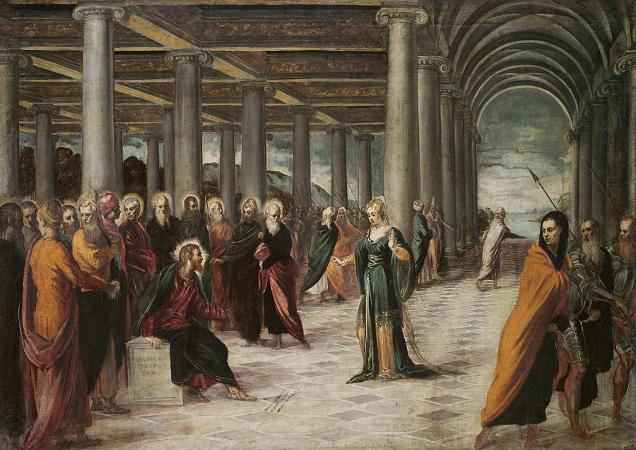Christ and Woman Taken in Adultery. Jesus and the woman taken in adultery is a passage found in the Gospel of John 7:53-8:11, that has been the subject of much scholarly discussion. In the passage, Jesus has sat down in the temple to teach some of the people, after he spent the previous night at the Mount of Olives. A group of scribes and Pharisees confronts Jesus, interrupting his teaching session. They bring in a woman, accusing her of committing adultery, claiming she was caught in the very act. They ask Jesus whether the punishment for someone like her should be stoning, as prescribed by Mosaic Law. Jesus first ignores the interruption and writes on the ground as though he does not hear them. But when the woman's accusers continue their challenge, he states that the one who is without sin is the one who should cast the first stone. The accusers and congregants depart realising not one of them is without sin, leaving Jesus alone with the woman. Jesus asks the woman if anyone has condemned her. She answers that no one has condemned her. Jesus says that he, too, does not condemn her, and tells her to go and sin no more. Many analysts of the Greek text and manuscripts of the Gospel of John have argued that it was certainly not part of the original text of St. John's Gospel. The Jerusalem Bible claims the author of this passage is not John. Leo the Great, cited the passage in his 62nd Sermon, mentioning that Jesus said to the adulteress who was brought to him, Neither will I condemn you; go and sin no more.' In the early 400s, Augustine of Hippo used the passage extensively, and from his writings, it is also clear that his contemporary Faustus also used it. The Council of Trent, held between 1545 and 1563, declared that the Latin Vulgate was authentic and authoritative. In terms of simple quantities, 1,495 Greek manuscripts include the pericope adulterae, and 267 do not include it. Among those 267, however, are some manuscripts which are exceptionally early and which most textual analysts consider the most important. The subject of Jesus' writing on the ground was fairly common in art, especially from the Renaissance onwards, with examples by artists including those by Pieter Bruegel and Rembrandt. There was a medieval tradition, originating in a comment attributed to Ambrose, that the words written were terra terram accusat, which is shown in some depictions in art, for example, the Codex Egberti. This is very probably a matter of guesswork based on Jeremiah 17:13. There have been other theories about what Jesus wrote, including speculation that His writing twice on the stone floor of the temple symbolized God's writing of the Ten Commandments twice on stone tablets.
more...











